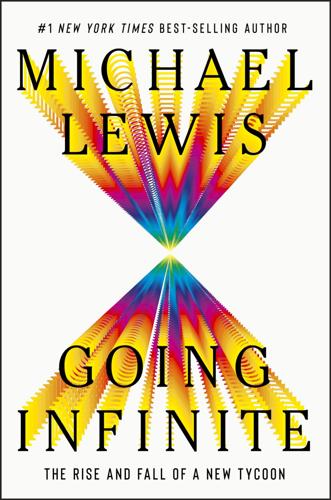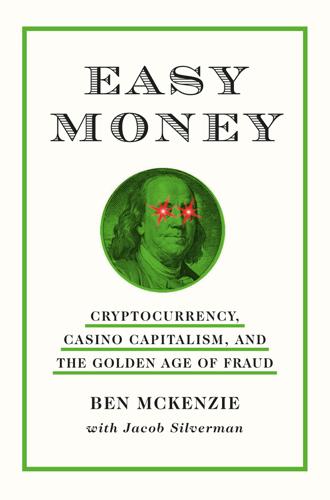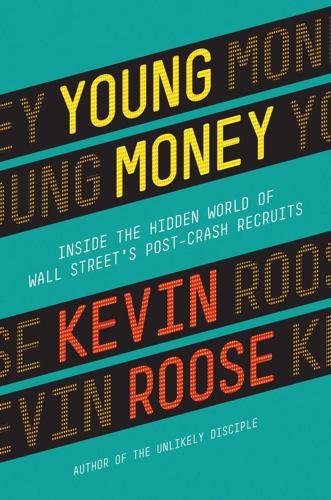
Going Infinite: The Rise and Fall of a New Tycoon
by
Michael Lewis
Published 2 Oct 2023
He was surprised when three different high-frequency trading firms emailed him to invite him to interview for their summer internships: Susquehanna, Wolverine, and Jane Street Capital. “It turned out that this was a real thing,” he said. Exactly what it was remained a mystery, even after the firms had reached out to him. You couldn’t just google “Jane Street Capital” and learn anything useful about the place. There was hardly anything about Jane Street Capital on the internet.¶ “I had no idea what to expect,” said Sam. “I didn’t even know what types of interviews these were going to be.” He had three phone interviews with Jane Street traders, and they were like no interviews he’d ever heard of.
…
That fall of 2012, a student of Peter Singer’s at Princeton had just become the first college student, to Singer’s knowledge, to take a job on Wall Street for the express purpose of making money to give away. His name was Matt Wage, and he’d been hired by Jane Street Capital. In the presence of strange new games, the relevant thought processes just seemed to come to Sam. In the presence of strange new people, not so much—though it took Jane Street Capital a bit longer to figure that out. That’s something they hadn’t tested for in the interviews. But at the end of the summer of 2013, nine months after they’d hired him, Jane Street executives sat Sam down to discuss his performance. The strengths he’d revealed in the interviews were still clearly strengths.
…
They thought he needed to learn how to read other people. Sam believed the opposite was true. “I read people pretty well,” he said. “They just didn’t read me.” * * * ¶ Jane Street Capital, like the other high-frequency trading firms, felt very strongly that it was better off if the public did not know what it did. “The first time a New York Times piece appeared about them, there was like a nuclear meltdown,” recalled one former Jane Street employee—who, like the other ten current and former Jane Street employees who helped me to understand what went on there, prefers to remain unidentified. * He’d later change it to Will MacAskill, so I’ll do that here too

Number Go Up: Inside Crypto's Wild Rise and Staggering Fall
by
Zeke Faux
Published 11 Sep 2023
When I spoke with MacAskill, he laughed when he remembered Bankman-Fried’s matter-of-fact response: “He basically said, ‘Yep, that makes sense.’ ” Another young MacAskill acolyte had gone to work for Jane Street Capital, a stock trading firm. It was one of a handful of companies that had used mathematical models and computer programs to take over the business of making markets on Wall Street. Anytime someone bought or sold a share of a stock or exchange-traded fund, there was a decent chance Jane Street was on the other side. Entry-level jobs there paid around $200,000 annually. Bankman-Fried secured an internship at the trading firm. And after graduation, he moved to New York to work there.
…
See also Alameda Research betting against Tether, 70 Platinum Partners, 72 as short sellers, 70, 72 as Tether users, 26–27 Held, Dan, 21 Herbert, Stacy, 204–205, 210, 239 Hiaasen, Carl, 14 Hiếu, Ngô Minh, 182–183, 185 “High in the Cemetery” (Morgan), 99 Hilton, Paris, 141 Hindenburg Research, 72–73 Ho, Vicky, 172–175, 180, 183 Hoegner, Stuart, 69 Hollywood Reporter, 155 Hong Kong, 87, 223 “How to Social Engineer Your Way Into Anything” (Morgan), 103 human trafficking, 193–195 Hun Sen, 190 Hurley, Mitch, 240–241, 242 Hydra Market, 108 I Icetoad, 176–177, 178, 179, 182 Il Blog delle Stelle, 43–44 “initial coin offerings” (ICOs) as bust, 87 described, 35 Ethereum and, 113 “pump-and-dump” schemes and, 49–50 Internet Gaming Entertainment (IGE), 34 J James, Letitia, 64 Jan, Richard, 193, 195 Janczewski, Chris, 104–105, 106 Jane Street Capital, 83, 84 Jeter, Derek, 129 K Keeton-Olsen, Danielle as scam compounds guide, 192–195, 196, 198, 199 basic facts about, 191 story about Chinatown, 197 Keiser, Max, 22, 204–205, 210, 239 Kim Jong Un, 127 Knight, Marion “Suge,” 32 Koutoulas, James, 29–30 Kraken, 21, 61 Kramer, Todd, 146 KuCoin, 102 Kwon, Do, 162, 163, 238 L Lai, Lennix, 215 Lansky, Meyer, 76 Lapina, Arthur, “Art Art,” 121–122, 125 Larsen, Aleksander, 123 laser eyes, 22 Latham & Watkins, 59 Lazarus hacker group, 102 Ledger Labs, 102–103 Lehman Brothers, 18 Levine, Matt, 49, 134, 135 Lewis, Michael, 130–131, 236 Liberty Reserve, 37 Lichtenstein, Ilya “Dutch” basic facts about, 98, 100–101, 106 Life magazine, 77 Lincoln, Abraham, 71 Loney, Patrick, 139–140 Loot, 143–144 Lugano, Switzerland, 207, 208, 209–210 Luna, 162–163, 165, 166, 226 M MacAskill, Will, 82–83, 216, 231 Mac Aulay, Tara, 84, 85, 87 Madoff, Bernie, 45, 232 Magic: The Gathering Online eXchange (Mt.
…
His logic here is hard to follow for a non-utilitarian. Here he was, already on a glide path into the 1 percent, and he was thinking he should find something riskier to do. But, like he always did, Bankman-Fried evaluated the decision by expected value. Expected value is a weighted average of potential outcomes. Let’s posit that his Jane Street career was 100 percent sure to generate $10 million in lifetime earnings. That would be its expected value. Another option he considered was founding a start-up. That had, say, a 95 percent chance of failing and generating nothing. But if Bankman-Fried thought that it had even a 5 percent chance of turning into a billion-dollar unicorn, that would give it a much higher expected value: $50 million.

Easy Money: Cryptocurrency, Casino Capitalism, and the Golden Age of Fraud
by
Ben McKenzie
and
Jacob Silverman
Published 17 Jul 2023
In order to advance Sam’s EA aspirations, MacAskill offered him a piece of advice: Apply for an internship at Jane Street Capital. The prestigious Wall Street trading firm is known for hiring the most brilliant grads from elite universities. Sam got the internship, excelled in it, and was offered a full-time position following graduation. At Jane Street, Sam could apply his considerable quant skills to figuring out ways to arbitrage minor differences in price to produce massive profits. He was tasked with providing market-making services trading global exchange-traded funds (ETFs). The specifics of that field are not important for us here, just the obvious: At Jane Street, Sam Bankman-Fried was still playing games.
…
Sam quickly realized there was a lot of money to be made exploiting the difference—buy Bitcoin in the United States, sell it in South Korea, pocket the difference. He started his own trading firm, Alameda Research, to take advantage of it. Sam recruited a few close friends from MIT, including roommate Gary Wang, whom he had known since meeting him in high school math camp, and Jane Street colleagues like Caroline Ellison, with whom he had become close. They began operating out of a small space in Berkeley, not far from where Sam grew up. Eventually the kimchi premium dried up, but there were still massive inefficiencies to be exploited in the nascent crypto market. In 2019, Sam moved Alameda Research to Hong Kong in search of a more favorable regulatory environment.
…
The inner circle of the FTX/Alameda team lived in the same penthouse together and had personal ties to Sam. Nishad Singh, Director of Engineering at FTX, was a high school friend of Sam’s brother. Gary Wang, FTX’s cofounder, had known Bankman-Fried since math camp in high school. Caroline Ellison, the CEO of Alameda Research, worked with him at Jane Street. Caroline and Sam occasionally dated. All nine of the roommates were thirty years old or less. Another troubling aspect of Sam’s operations was the size of his political donations. Sam was Biden’s second-largest donor in 2020. He’d given $40 million to the Dems. His partner at FTX, Ryan Salame, gave $23 million to the Republicans.

On the Edge: The Art of Risking Everything
by
Nate Silver
Published 12 Aug 2024
No-Shits-Left-to-Give Sam could get dark and erratic—this was the version that I was a tiny bit worried might suddenly lunge for my digital recorder. Finally, there was Sneaky Sam. This iteration of SBF was pedantic and lawyerly. Although Talking-Shop Sam saw me as an equal, Sneaky Sam was full of gotcha questions, quizzing me as though I was his intern at Jane Street Capital. I got the sense that Sneaky Sam was using me to audition his arguments—if he could outwit me, maybe he could eventually outwit the media, the prosecutors, and a jury. “I’m curious, by the way; what’s your thoughts on that?” Sneaky Sam asked me after claiming that FTX could have averted disaster if only he hadn’t declared bankruptcy and had been able to raise more capital.
…
Ord had been influenced by Peter Singer, and Ord in turn was a huge influence on MacAskill from the moment they got “coffee in a graveyard in the back of St. Edmund Hall,” MacAskill told me. One of the lead writers at Overcoming Bias was Yudkowsky. Hanson and Yudkowsky had something of a falling-out over their competing assumptions about p(doom)—Yudkowsky’s p(doom) is high and Hanson’s is low—and had a debate on AI risk at Jane Street Capital in 2011, the firm that would later employ SBF. Some of the rationalist interest in prediction markets also stems from Hanson, who has expressed his support for futarchy, a system of government where decisions are made by betting markets. These various strands have been tied together from the beginning, the product of a bloggier era in the 2000s and early 2010s when there were fewer people arguing on the internet and the discussion was nerdier and more free-flowing.
…
GO TO NOTE REFERENCE IN TEXT Hanson founded his blog: Robin Hanson, “How to Join,” Overcoming Bias (blog), July 22, 2023, overcomingbias.com/p/introductionhtml. GO TO NOTE REFERENCE IN TEXT Hanson and Yudkowsky: Per interview with Robin Hanson. GO TO NOTE REFERENCE IN TEXT risk at Jane Street Capital: “The Hanson-Yudkowsky AI-Foom Debate,” LessWrong, accessed January 2, 2024, lesswrong.com/tag/the-hanson-yudkowsky-ai-foom-debate. GO TO NOTE REFERENCE IN TEXT support for futarchy: Robin Hanson, “Futarchy: Vote Values, but Bet Beliefs,” accessed January 2, 2024, mason.gmu.edu/~rhanson/futarchy.html.

Young Money: Inside the Hidden World of Wall Street's Post-Crash Recruits
by
Kevin Roose
Published 18 Feb 2014
Trumping them all was the Anheuser-Busch booth near the back of the gym, where Princeton alumni in red track jackets were giving out free, Budweiser-branded sunglasses under a sign that read: “Increase your liquid assets!” The financial firms in attendance were using largely the same vague pitches I’d heard years earlier at Wharton. One bank advertised its “global transaction advisory for the new economy.” Another offered students a chance to “bring your career into focus.” Jane Street Capital, a medium-sized hedge fund, had a banner promising its recruits a “dynamic, challenging environment. Rapid advancement. Idea-driven meritocracy. Informal fun and open atmosphere.” (Oh, and last on the list: “Generous compensation.”) I walked around the gym for an hour, listening to recruiters attempting to reel in students with time-tested come-ons: “I love my job, and I love what I do.”

Breaking Twitter: Elon Musk and the Most Controversial Corporate Takeover in History
by
Ben Mezrich
Published 6 Nov 2023
Even for Silicon Valley, the vision on the screen seemed unkempt; as the panda started talking, his words coming so fast they were nearly slamming into each other, the alarm bells began to ring. Elon was no stranger to the mythology that had grown up around the kid: Sam Bankman-Fried, or SBF as he was generally known in the tech press, was considered one of the most brilliant young entrepreneurs of the past decade. After first making a name for himself at Jane Street Capital, then starting his own quantitative trading firm, called Alameda Research, at thirty, SBF had founded FTX, one of the fastest-growing crypto exchanges in the world. The stories about SBF were legendary, and unavoidable. How he’d first pitched FTX to a room full of Sequoia Capital VCs, waxing poetic about making his exchange “a place where you can do anything you want with your next dollar,” from buying crypto to art to goddamn produce, all the while his head hovered inches above his laptop, never once breaking from the screen to make eye contact.